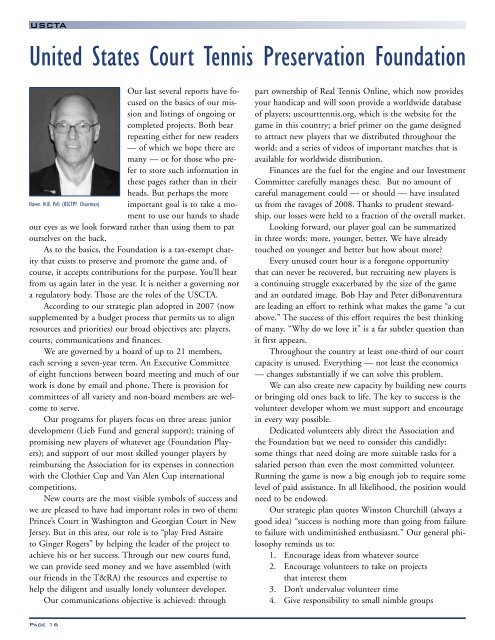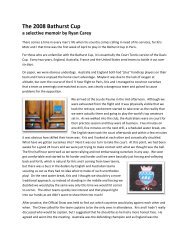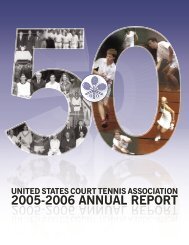united states court tennis association united states court tennis ...
united states court tennis association united states court tennis ...
united states court tennis association united states court tennis ...
You also want an ePaper? Increase the reach of your titles
YUMPU automatically turns print PDFs into web optimized ePapers that Google loves.
USCTA<br />
United States Court Tennis Preservation Foundation<br />
Our last several reports have focused<br />
on the basics of our mission<br />
and listings of ongoing or<br />
completed projects. Both bear<br />
repeating either for new readers<br />
— of which we hope there are<br />
many — or for those who prefer<br />
to store such information in<br />
these pages rather than in their<br />
heads. But perhaps the more<br />
Haven N.B. Pell (USCTPF Chairman)<br />
important goal is to take a moment<br />
to use our hands to shade<br />
our eyes as we look forward rather than using them to pat<br />
ourselves on the back.<br />
As to the basics, the Foundation is a tax-exempt charity<br />
that exists to preserve and promote the game and, of<br />
course, it accepts contributions for the purpose. You’ll hear<br />
from us again later in the year. It is neither a governing nor<br />
a regulatory body. Those are the roles of the USCTA.<br />
According to our strategic plan adopted in 2007 (now<br />
supplemented by a budget process that permits us to align<br />
resources and priorities) our broad objectives are: players,<br />
<strong>court</strong>s, communications and finances.<br />
We are governed by a board of up to 21 members,<br />
each serving a seven-year term. An Executive Committee<br />
of eight functions between board meeting and much of our<br />
work is done by email and phone. There is provision for<br />
committees of all variety and non-board members are welcome<br />
to serve.<br />
Our programs for players focus on three areas: junior<br />
development (Lieb Fund and general support); training of<br />
promising new players of whatever age (Foundation Players);<br />
and support of our most skilled younger players by<br />
reimbursing the Association for its expenses in connection<br />
with the Clothier Cup and Van Alen Cup international<br />
competitions.<br />
New <strong>court</strong>s are the most visible symbols of success and<br />
we are pleased to have had important roles in two of them:<br />
Prince’s Court in Washington and Georgian Court in New<br />
Jersey. But in this area, our role is to “play Fred Astaire<br />
to Ginger Rogers” by helping the leader of the project to<br />
achieve his or her success. Through our new <strong>court</strong>s fund,<br />
we can provide seed money and we have assembled (with<br />
our friends in the T&RA) the resources and expertise to<br />
help the diligent and usually lonely volunteer developer.<br />
Our communications objective is achieved: through<br />
Page 16<br />
part ownership of Real Tennis Online, which now provides<br />
your handicap and will soon provide a worldwide database<br />
of players; us<strong>court</strong><strong>tennis</strong>.org, which is the website for the<br />
game in this country; a brief primer on the game designed<br />
to attract new players that we distributed throughout the<br />
world; and a series of videos of important matches that is<br />
available for worldwide distribution.<br />
Finances are the fuel for the engine and our Investment<br />
Committee carefully manages these. But no amount of<br />
careful management could — or should — have insulated<br />
us from the ravages of 2008. Thanks to prudent stewardship,<br />
our losses were held to a fraction of the overall market.<br />
Looking forward, our player goal can be summarized<br />
in three words: more, younger, better. We have already<br />
touched on younger and better but how about more?<br />
Every unused <strong>court</strong> hour is a foregone opportunity<br />
that can never be recovered, but recruiting new players is<br />
a continuing struggle exacerbated by the size of the game<br />
and an outdated image. Bob Hay and Peter diBonaventura<br />
are leading an effort to rethink what makes the game “a cut<br />
above.” The success of this effort requires the best thinking<br />
of many. “Why do we love it” is a far subtler question than<br />
it first appears.<br />
Throughout the country at least one-third of our <strong>court</strong><br />
capacity is unused. Everything — not least the economics<br />
— changes substantially if we can solve this problem.<br />
We can also create new capacity by building new <strong>court</strong>s<br />
or bringing old ones back to life. The key to success is the<br />
volunteer developer whom we must support and encourage<br />
in every way possible.<br />
Dedicated volunteers ably direct the Association and<br />
the Foundation but we need to consider this candidly:<br />
some things that need doing are more suitable tasks for a<br />
salaried person than even the most committed volunteer.<br />
Running the game is now a big enough job to require some<br />
level of paid assistance. In all likelihood, the position would<br />
need to be endowed.<br />
Our strategic plan quotes Winston Churchill (always a<br />
good idea) “success is nothing more than going from failure<br />
to failure with undiminished enthusiasm.” Our general philosophy<br />
reminds us to:<br />
1. Encourage ideas from whatever source<br />
2. Encourage volunteers to take on projects<br />
that interest them<br />
3. Don’t undervalue volunteer time<br />
4. Give responsibility to small nimble groups




